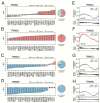The Association between TIF1 Family Members and Cancer Stemness in Solid Tumors
- PMID: 33810347
- PMCID: PMC8061774
- DOI: 10.3390/cancers13071528
The Association between TIF1 Family Members and Cancer Stemness in Solid Tumors
Abstract
Cancer progression entails a gradual loss of a differentiated phenotype in parallel with the acquisition of stem cell-like features. Cancer de-differentiation and the acquisition of stemness features are mediated by the transcriptional and epigenetic dysregulation of cancer cells. Here, using publicly available data from The Cancer Genome Atlas (TCGA) and Gene Expression Omnibus (GEO) databases and harnessing several bioinformatic tools, we characterized the association between Transcriptional Intermediary Factor 1 (TIF1) family members and cancer stemness in 27 distinct types of solid tumors. We aimed to define the prognostic value for TIF1 members in predicting a stem cell-like cancer phenotype and patient outcome. Our results demonstrate that high expression of only one member of the TIF1 family, namely TIF1β (also known as Tripartite Motif protein 28, TRIM28) is consequently associated with enriched cancer stemness across the tested solid tumor types, resulting in a worse prognosis for cancer patients. TRIM28 is highly expressed in higher grade tumors that exhibit stem cell-like traits. In contrast to other TIF1 members, only TIF1β/TRIM28-associated gene expression profiles were robustly enriched with stemness markers regardless of the tumor type. Our work demonstrates that TIF1 family members exhibit distinct expression patterns in stem cell-like tumors, despite their structural and functional similarity. Among other TIF1 members, only TRIM28 might serve as a marker of cancer stemness features.
Keywords: TCGA; TIF1; TRIM28; cancer stemness; stemness score.
Conflict of interest statement
The authors declare no conflict of interest. The funders had no role in the design of the study; in the collection, analyses, or interpretation of data; in the writing of the manuscript, or in the decision to publish the results.
Figures






Similar articles
-
Mining Transcriptomic Data to Uncover the Association between CBX Family Members and Cancer Stemness.Int J Mol Sci. 2022 Oct 28;23(21):13083. doi: 10.3390/ijms232113083. Int J Mol Sci. 2022. PMID: 36361869 Free PMC article.
-
The association between bromodomain proteins and cancer stemness in different solid tumor types.Int J Cancer. 2022 Jun 1;150(11):1838-1849. doi: 10.1002/ijc.33937. Epub 2022 Jan 29. Int J Cancer. 2022. PMID: 35049055 Free PMC article.
-
Melanoma Stem Cell-Like Phenotype and Significant Suppression of Immune Response within a Tumor Are Regulated by TRIM28 Protein.Cancers (Basel). 2020 Oct 15;12(10):2998. doi: 10.3390/cancers12102998. Cancers (Basel). 2020. PMID: 33076560 Free PMC article.
-
TIF1 Proteins in Genome Stability and Cancer.Cancers (Basel). 2020 Jul 28;12(8):2094. doi: 10.3390/cancers12082094. Cancers (Basel). 2020. PMID: 32731534 Free PMC article. Review.
-
The Immune Modulatory Role of TIF1 Proteins.Adv Exp Med Biol. 2024;1466:89-99. doi: 10.1007/978-981-97-7288-9_6. Adv Exp Med Biol. 2024. PMID: 39546137 Review.
Cited by
-
Low Levels of TRIM28-Interacting KRAB-ZNF Genes Associate with Cancer Stemness and Predict Poor Prognosis of Kidney Renal Clear Cell Carcinoma Patients.Cancers (Basel). 2021 Sep 28;13(19):4835. doi: 10.3390/cancers13194835. Cancers (Basel). 2021. PMID: 34638319 Free PMC article.
-
Myositis interstitial lung disease and autoantibodies.Front Med (Lausanne). 2023 Jun 13;10:1117071. doi: 10.3389/fmed.2023.1117071. eCollection 2023. Front Med (Lausanne). 2023. PMID: 37384043 Free PMC article. Review.
-
EGFR-induced lncRNA TRIDENT promotes drug resistance in non-small cell lung cancer via phospho-TRIM28-mediated DNA damage repair.Proc Natl Acad Sci U S A. 2025 Mar 11;122(10):e2415389122. doi: 10.1073/pnas.2415389122. Epub 2025 Mar 3. Proc Natl Acad Sci U S A. 2025. PMID: 40030013 Free PMC article.
-
Mining Transcriptomic Data to Uncover the Association between CBX Family Members and Cancer Stemness.Int J Mol Sci. 2022 Oct 28;23(21):13083. doi: 10.3390/ijms232113083. Int J Mol Sci. 2022. PMID: 36361869 Free PMC article.
-
The Epigenetic Modifiers HDAC2 and HDAC7 Inversely Associate with Cancer Stemness and Immunity in Solid Tumors.Int J Mol Sci. 2024 Jul 17;25(14):7841. doi: 10.3390/ijms25147841. Int J Mol Sci. 2024. PMID: 39063083 Free PMC article.
References
Grants and funding
LinkOut - more resources
Full Text Sources
Other Literature Sources
Miscellaneous

